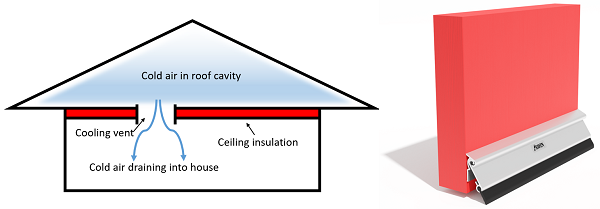I’ve lived in a lot of houses, in a lot of very hot and very cold places (thanks Army!) and I’ve picked up a trick or two along the way. What follows are just a few tips that will keep your home more comfortable (be that cooler or warmer), and will probably save you money.
Tip 1 – Rectify draughts under doors.
A draught is the name given to any uncontrolled movement of air. The various draughts that are moving into or out of your house can have a combined effect equivalent to that of leaving one or more windows open.
If it’s summer and your house, or part thereof, is air-conditioned; go the non-air-conditioned side of a door and get your down near the crack under the door. What do you feel?
Conversely if it’s winter and your house is heated and/or closed up to keep warm; stay in the warm part of your house, move to a door that opens to outside or a non-heated part of your house and, again, get down near the crack under the door. What do you feel?
If there’s cool air flowing under the door, you have a draught. You may even be surprised by the sheer volume and velocity of the cool air getting under some doors. Cool draughts will be aided by the fact that cold air settles (opposite to how hot air rises) so gravity will be helping to push the cool air under your door.
For doors that are internal to you house it’s common for there to be nothing to stop draughts getting under them, while external doors generally have a weather seal of some sort fitted to them (see Figure 1). However, weather seals are primarily designed to keep rain out and are rarely 100% effective at stopping draughts.
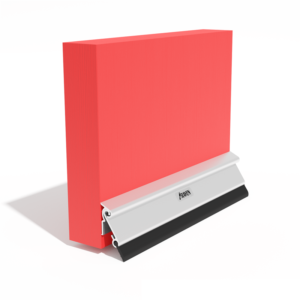
There are a few options to rectify draughts under doors, repairing or replacing damaged weather seals is one, there are foam/fabric internal door seals that are inexpensively and can be fitted very easily (Figure 2), and there is the old-fashioned ‘door-snake’ / draught excluders (Figure 3).
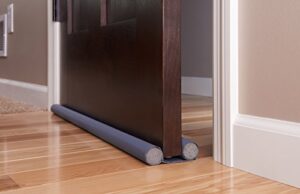
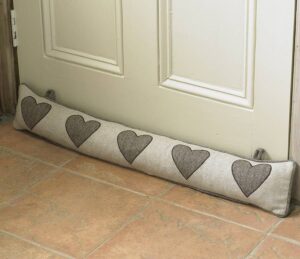
My preference is not to use the foam/fabric internal seals because they have a tendency to slide out from under doors when they’re opened and closed, plus they don’t give the greatest seal. I’m also biased against the old-fashioned door snakes because they need to be put back into position every time the door is opened. For these reasons I found a more robust and unobtrusive door seal for the doors the houses I lived in. These seals are made from strips of vinyl (Figure 4), that are cut to fit, and seal, the gap perfectly. They’re fixed to the back of the door with adhesive, which I like to augment with tacks or staples to make doubly sure that they stay in place. I’ve found this method so effective (and inexpensive) that I also fit them to the inside of external doors to complement the effect of the weather-seal on the outside.
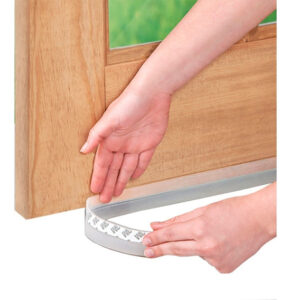
Tip 2 – Check your vents.
This tip is only going to be relevant to those with ducted cooling (be it evaporative cooling or air-conditioning) coming into their house via ceiling vents.
The very short version of this is: “in winter CLOSE your cooling vents!” or if they’re not designed to be closed; BLOCK them.
The longer version is: Think about when you open your refrigerator on a hot summer day; a torrent of cold air cascades over your feet as it pours out of the opened door like water from a burst damn (remembering form above; cold air settles / hot air rises). The same thing is going to occur in winter, if the cooling vents in your ceiling are left open. At night in particular, your roof cavity will cool to a temperature cooler than the temperature that you want your house to be, open cooling vents will allow an avenue for the air in the cooling ducts in your roof cavity to bypass any insulation you have in your ceiling and drain into your living space. Concurrently, warm air from the warmest part of your house can rise into the ducting in your roof cavity via open cooling vents, where it will cool and then drain back into your house either through the same cooling vent or a different one.

If you’re paying to heat your home and your cooling vents are open, you’re likely to be paying a lot of money to: (A). overcome the cool air that’s coming into your home via multiple vents, and (B). heat air that is going to rise through open cooling vents and then cool in your roof cavity. Even if you’re not actively heating your house, closing your cooling vents in winter will help keep you warmer and more comfortable.
So to reiterate: in winter CLOSE (or block) your cooling vents.
Tip 3 – Crack out the tent!
This is going to get you ridiculed by your friends, but it’s extremely effective!
If you: (A). Cannot afford to heat your house or want to save $$$ heating your house; (B) Have so many draughts in your house that you can’t close them all off; (C). Are adversely affected by the dry air in winter and/or the dry air created by heating your home in winter; and/or (D). Are prepared to doggedly deflect ridicule from your friends and family. Then this is the solution for you!
But seriously it works, it will keep you fantastically cosy and humidified in winter and if it displaces the use of heating it will save you hundreds or thousands of dollars each year. How? By putting inexpensive dome tents over your beds. A three-man dome tent ($40-70 and 5 minutes to erect) sits nicely on top of a king-sized bed, and a 1-2 man dome tent / mosquito dome (I’m not sure what they cost? Thanks Army!) with a fly fits nicely on top of a single or king single bed.

So how did I get this unorthodox but ingenious idea? I hear you think. Some years ago I was posted to regional Victoria, where overnight temperatures would get down to freezing in winter. By happenstance I used to keep a two man mosquito dome with a fly set up in the living area with my swag rolled out inside of it. The primary purpose of this setup was to provide a cozy play nook for the kids, but my wife and I realised that if were feeling sick, particularly with upper respiratory track ailments, we could sleep in it, and the warmth and humidity did wonders for us. Then; on one occasion we were both sick at the same time. Unfortunately; In spite of its name two people just can’t sleep comfortably in a two-man mosquito dome tent; so I cracked out our three-man dome tent and put it on top of our king-sized bed. I lined the floor with a quilt and threw our pillows, sheets and blankets in and I never looked back. When we recovered from our ailments we resolved to keep the tent in place for the rest of the winter as it was just too warm and cozy to give up. We also put mozzie domes, with flys, over our kids’ beds. Yes; we got some weird looks form visiting friends and we had to explain ourselves more than once, but we were also able to turn the heating off for the entire evening, we saved hundreds of dollars in heating each quarter, and we no longer suffered the drying effects of sleeping in a heated house.
Now we live in north Queensland, but we still employ the two-man tent to great effect if our kids get sick in winter.
That’s all for now.
There are enough tips and ideas for keeping your home cooler or warmer to fill several more posts, but I’ll save them for another time.
I hope the above tips inspire you to try something new. If you‘d like me to assist you with home energy efficiency please don’t hesitate to contact me.

